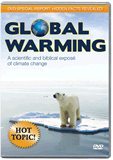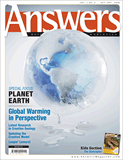
Cosmos Review: “World Set Free”
Episode 12 of Cosmos: A SpaceTime Odyssey
Cosmos Articles and Discussion Guides
See Cosmos: A SpaceTime Odyssey for reviews of other episodes and discussion guides for further study.
Cosmos: A SpaceTime Odyssey episode 12, “World Set Free,” is entirely devoted to convincing viewers that dangerous man-made global warming threatens to destroy our planet. If we as a world fail to act soon, Cosmos host Neil deGrasse Tyson warns, we will tip ourselves beyond the point of no return and destroy life as we know it.
Truth and Consequences
As Bible-believing Christians we know that we are responsible to be good stewards of the Earth God created, protecting both planet and people from preventable destruction. While there is good evidence that the overall temperature worldwide has risen slightly over the past four centuries, is that a catastrophic trend? And is human burning of fossil fuels the cause? Could Cosmos host Tyson be wrong in his emphatic declarations that the carbon dioxide produced by humans is the cause of rising temperatures and will propel us toward destruction?
Dr. Tyson paints a dire picture of our future, parading the planet Venus as the poster-child for a runaway greenhouse effect. At the end of the program, he offers “a breathtaking vision of the magnificent future that is scientifically and technically within our grasp, if we will only awaken and seize it.”1 Concerned, conscientious people might then ask, “Why take a chance? If there is even a possibility we are hurting our planet, shouldn’t we change our way of life just in case?” The answer is “no.”
We must be sure of our facts. And those “facts” are neither as easy to come by nor as clear to interpret as Dr. Tyson claims.
The repercussions of drastic action would hurt a lot of people, especially the poorer among us. Therefore, if the problem is not perilous, man-made, or man-fixable, a worldwide civilization overhaul is neither necessary nor advisable. We must be sure of our facts. And those “facts” are neither as easy to come by nor as clear to interpret as Dr. Tyson claims.
Dr. Alan White,2 who holds a PhD in organic chemistry from Harvard University, has authored 18 peer-reviewed scientific papers, and travels internationally lecturing on both the biblical and scientific aspects of climate change and global warming, says,
Dr. Tyson seems to be implying at the end of the program that all we have to do as a worldwide community is to accept the “truth” of man-caused global warming and stop burning fossil fuels. He implies that there are no consequences to the changes that he is suggesting and that the results are certain. I believe the consequences would be enormous and the resulting change in global temperature would be insignificant. It seems to me that forcing all people on the Earth (if you could) to use more expensive sources of energy would lower the standard of living of everyone. Before I would want to propose that the world take such a drastic step, I would want to make sure that I was right about the scientific issues. At present, the case for man being the cause of global warming is very weak, and it is far from certain that the global temperature will continue its slow rise.
Greenhouse Effect
As with most Cosmos episodes, observable scientific information is placed alongside worldview-dependent interpretations. Tyson explains the basic physics of the greenhouse effect. Without some greenhouse effect, our planet would not be warm enough for us. As the sun warms the Earth’s surface, infrared radiation is emitted from the warm surfaces, whether land or sea, and would escape and leave us cold. The greenhouse effect involves the trapping of some of that warmth by a blanket of “greenhouse gases” to keep the Earth and its lower atmosphere warm.
Carbon dioxide, which is utilized by growing plants and released from burning fossil fuels, is just such a greenhouse gas. Tyson describes Charles Keeling’s discovery of the seasonal trend in atmospheric carbon dioxide. Levels tend to fall in the spring as forests widespread in the northern hemisphere take in large quantities of carbon dioxide and to rise in the autumn as fallen leaves decay. But this seasonal variation has not been the only observable change in carbon dioxide levels. Carbon dioxide in the atmosphere has been systematically measured at the South Pole, Hawaii’s Mauna Loa Observatory, or both since 1958. There has been a generally upward trend.
The greenhouse effect as well as these variations and trends in atmospheric carbon dioxide levels are observable. But whether the generally upward trend in carbon dioxide levels is causally related to observed temperature changes over the same period is highly speculative.
Chief of the Greenhouse Gases?
Water vapor and clouds are responsible for the bulk of our greenhouse effect.
Dr. Tyson claims that carbon dioxide is “the chief climate-regulating gas of our global thermostat,” a blatantly incorrect claim that ignores the overwhelming importance of water vapor. Cosmos spends its television hour focusing on anthropogenic carbon dioxide as the culprit stalking our destiny. But the gas with the greatest contribution to our blanket is water vapor. Water vapor and clouds are responsible for the bulk of our greenhouse effect. Dr. Tyson neglects this inconvenient fact. Dr. White points out,
You have been led to believe that the most important greenhouse gas is carbon dioxide. It is not. Water vapor and clouds are actually responsible for about 80 to 90 percent of the total greenhouse effect. That’s right, at least 80 percent. That is why clear mornings are usually much colder than cloudy mornings. On clear mornings, we do not have that blanket of clouds to hold in the heat.
The percentage of the greenhouse effect attributable to CO2 is believed to be as high as 20 percent by some and as low as 4 percent by others. Almost everyone agrees that the percent of CO2 that is man-made is only about 4 percent of total CO2. Therefore, the greenhouse effect caused by man-made CO2 is less than 1 percent of the total and may be a small fraction of 1 percent. (Quote from “Climate Change Facts: Should We Be Concerned?” in the New Answers Book 4.)
Looking Back
In most episodes of Cosmos, the worldview-based interpretations juxtaposed with observable scientific fact have involved millions-of-years evolutionary scenarios. What in the world could overblown interpretations of Earth’s age have to do with concerns about climate change? Here too, it turns out, as climate scientists try to define trends and extrapolate them to the future, what they believe about the unobservable past does make a difference. Atmospheric carbon dioxide has only been measured for a few decades. Temperature measurement records have only been available since 1880. Even at that it is very difficult even with modern technology to accurately measure the average global temperature of the Earth or the average global carbon dioxide concentration due to variation from place to place and from time to time.
Moreover, efforts to obtain estimates of past temperature and atmospheric conditions depend upon worldview-dependent assertions in what Dr. Tyson calls Earth’s “diary.” Yet claims about global temperature and carbon dioxide levels in the past “800,000 years” are based on a circle of unverifiable assumptions. Tyson says, “The Earth keeps a detailed diary written in the stones of yesteryear. Climate scientists drill ice cores in the depths of glaciers in Greenland and Antarctica. The ice layers have ancient air trapped inside them. We can read the unbroken record of Earth’s atmosphere. It extends back over the last 800,000 years.” Yet the vast ages assigned to these ice cores are based on dates assigned to compressed layers of ice presumed to be millions of years old.
Comparisons with the temperatures and atmospheres of climates in the deep past cannot be reliably assessed from ice cores. Past global temperatures deduced from the compressed layers of these ice cores are attributed to a series of historical ice ages and correlated with isotopes in seafloor sediments by evolutionary thinkers. Yet all these interlinked “events” stem from a web of circular reasoning and unverifiable worldview-based assumptions. (You can read more about these assumptions in Institute for Creation Research physicist Dr. Jake Hebert’s article “Ice Cores, Seafloor Sediments, and the Age of the Earth.”)
Historical Climate
Without reliable information about past climates or even about the global temperature averages and atmospheric conditions in recent centuries, can we compare any past climates to the present in an effort to predict the future? Actually, history serves this purpose in the absence of direct scientific measurements. Dr. White explains,
Historical accounts of the Medieval Warm Period (around a thousand years ago) reveal an era where there was farming in Greenland and little Arctic ice in the North Atlantic. This was before the Industrial Revolution, therefore, man-made CO2 should not have been a significant factor. How could it have been so hot back then? Our climate models would not have predicted this.
Causality?
Granting that atmospheric carbon dioxide has risen in recent decades, can we demonstrate a causal link to global temperatures? We cannot, as the inconsistencies and limitations of the current climate models attest. Dr. White says, “One of Dr. Tyson’s main points is that there is a direct link between the concentration of CO2 in the atmosphere and the global temperature. The facts don’t bear that out.” In addition to the testimony of history that tells of us of a pre-Industrial Medieval Warm Period that cannot be attributed to man’s carbon footprint, Dr. White explains,
Dr. Tyson makes a big deal about how accurately we can measure the CO2 concentration in the atmosphere and that it shows a steady increase since we have been able to measure it. However, the global temperature over the past several years has not correlated with that. One would think that now that we can more accurately measure both the global temperature and CO2 concentration that these would correlate, IF the theory were correct. But they don’t.
All of these facts point to the inaccuracy of our current climate models. Dr. Tyson implies that we understand climate better than we do weather when he leads his meandering dog on the beach.3 While weather and climate are clearly different, both are poorly understood today. It really doesn’t matter whether you watch the man or the dog.
We just don’t fully understand all basics of climate yet. Climate changes are incredibly complex. We just do not have enough accurate data over a long enough period of time to model it accurately. Tyson implies that we understand all the important factors. If we did, our current models would work. They don’t.
Feedback Loops
We know our world has survived climate cycles and swings for the 6,000 years since God created it.
Positive feedback loops, Dr. Tyson warns, will take the rise in temperature that the Earth has already experienced and propel us past the point of no return if the trend is not interrupted. Thawing permafrost will rot, he says, releasing more carbon dioxide and methane gas to further heat the atmosphere and lead to a runaway positive feedback loop of hot destruction. Additionally, replacement of sunlight-reflecting Arctic Sea ice with heat-absorbing dark ocean water will, he warns, create a positive feedback loop driving Earth to ever hotter temperatures if the world’s population fails to stop burning fossil fuels. But we know our world has survived climate cycles and swings for the 6,000 years since God created it. Man does not really understand earth’s climate very well, despite Tyson’s claim to the contrary. Could earth, like Tyson says of Venus, fall into the grip of catastrophic positive feedback loops like this, or are negative feedback loops in place to stabilize our world’s climates? Commenting on Venus’s positive feedback climate loop and the negative feedback loops protecting Earth, Dr. White comments,
None of us can know for sure what either planet [Venus or Earth] was like in the beginning. They are clearly very different today. One of the major differences is the presence of our oceans. The 310,000,000 cubic miles of water on the Earth’s surface today act as a massive heat sink that helps to stabilize our planet’s temperature. To me it makes sense that the Earth’s temperature has been so stable over its recent history due to the presence of an enormous amount of water and the hydrologic cycle.
One possible negative feedback system involves the hydrologic cycle. A higher temperature on Earth would cause more evaporation (which cools the Earth’s surface), more cloud formation, and likely more sunlight reflected away from the Earth. This negative feedback could help to stabilize the global temperature and could easily overwhelm any of the positive feedback systems. At present we don’t understand the relative magnitude of these different feedback systems.
Engineers familiar with control systems are well aware that control systems dependent on positive feedback easily go out of control whereas those based on negative feedback generally do not. Since the Earth’s temperature has been relatively stable for many centuries, it seems more likely that the Earth’s climate is moderated by one or more powerful negative feedback systems.
We have not seen the Earth rocketing upward to catastrophically hot temperatures. In fact, in the 1970s many scientists feared Earth had entered a catastrophic cooling trend! There is not—despite Dr. Tyson’s statements to the contrary—a consensus among climatologists that man’s contribution to atmospheric carbon dioxide is a significant cause of climate change or that atmospheric carbon dioxide is the cause of the modest rise in global temperature that seems to have taken place in recent years.
While additional research is needed, given political pressure to support projects that reinforce belief in man-made global warming as well as the link between popular evolutionary notions and many of the so-called “trends” in climate, it sadly may be difficult to obtain truly reliable unbiased information. Be sure to read more about this in Dr. Alan White’s analysis of the climate change controversy, “Climate Change Facts: Should We Be Concerned?”
For more information:
- Was the Medieval “Little Ice Age” Triggered by an Indonesian Volcano?
- Climate Change Facts: Should We Be Concerned?
- Climate Change Predictions Prove Miscalculated
- Is Man the Cause of Global Warming?
- Are We Globally Warming Our World to Death?
- Global Warming—When Politics and Science Collide
- The Solar System: Venus
- Ice Cores, Seafloor Sediments, and the Age of the Earth
- Do Ice Cores Disprove Recent Creation?
- Climategate: Begging the Question
Footnotes
- Ann Druyan, “Quests and Discussions for Students, Episode 12,” Cosmos Studios, http://static-media.fox.com/cosmos/Cosmos_Quest_Episode_12.pdf (accessed 4 June 2014).
- Dr. Alan White is the author of the New Answers Book 4 chapter titled “Climate Change Facts: Should We Be Concerned?” Dr. White holds a PhD in organic chemistry from Harvard University. He worked as a research fellow for Eastman Chemical Company, holds 41 U.S. patents, and has authored 18 peer-reviewed scientific papers. He now travels internationally, lecturing on both the biblical and scientific aspects of climate change and global warming.
- The program shows a birds-eye view of Dr. Tyson leading a meandering dog along the beach. The unpredictable dog’s path represents the unpredictability of weather while Dr. Tyson, with a straight predictable path, represents scientifically predictable climate changes. Dr. White points out that climate and the many factors that affect it are poorly understood at present, despite Dr. Tyson’s claim to the contrary.
Recommended Resources

Answers in Genesis is an apologetics ministry, dedicated to helping Christians defend their faith and proclaim the good news of Jesus Christ.
- Customer Service 800.778.3390
- Available Monday–Friday | 9 AM–5 PM ET
- © 2025 Answers in Genesis





